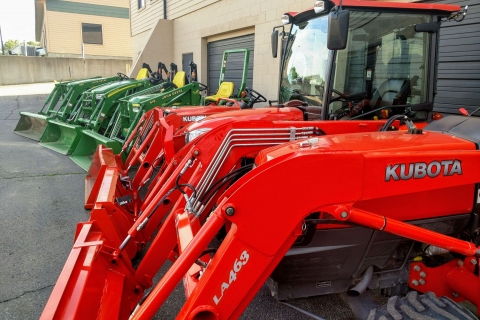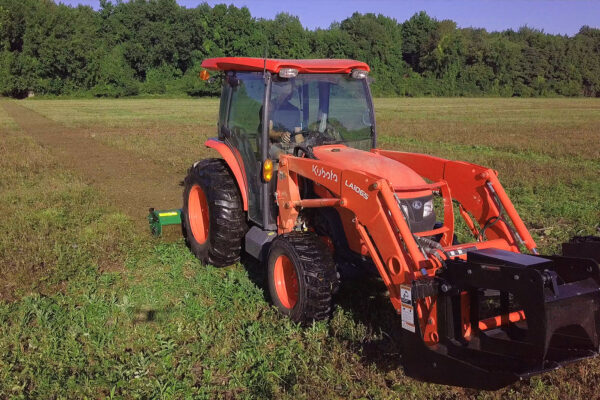To be entirely forthright, let me preface by stating that I’m not affiliated with John Deere nor Kubota. In the Kubota vs John Deere debate, you really cannot pick a loser. I really enjoy operating and selling both brands of compact tractors and have found their historical reputations of quality to ring true still today. That doesn’t mean that I think either tractor is perfect or that one doesn’t best the other in certain areas. This is based on one man’s experience who is fortunate enough to have hundreds of used tractors come across his doorstep each year. Varying models, conditions, hours, and attachments leave me with a unique perspective that I hope helps others in the search for their perfect tractor. Without further ado, we’ll dive into five areas that Kubota beats John Deere or watch the video here.
The first area is actually the front end loader. Nope, it’s not a superior lift capacity. In fact, I’ve found those specs to essentially be a wash between the two brands. Instead, it’s going to be the ability to work the joystick to the corners of the control valve allowing for two-function operation. What this means is that you can curl and raise the bucket at the same time or drop and dump at the same time among other combinations. For instance, this is a very handy feature when you have a set of pallet forks on and trying to raise the load and keep the load level at the same time. This is something that isn’t designed into a John Deere. I will say I’ve been able to mimic the process on John Deere, however it takes a high degree of focus and the “sweet spot” to enable this dual function is microscopic.
SHOP GOOD WORKS TRACTORS INVENTORY! WE CAN SHIP ANYWHERE IN THE CONTINENTAL US!
Sticking with the front end loaders, we’ll also discuss the standard loader being of the “quick park” variety. Even in basic Kubota tractor models, you’ll find yourself with a quick park loader as the base option. Many folks don’t have a need to remove a front end loader, but it is especially useful to remove a loader on a tractor with a belly mower. Those buckets tend to get in the way of everything when mowing a yard. There’s of course other reasons to remove a loader as well and you’ll find John Deere’s value 3e Series and 4m Series include fixed mount loaders that won’t quickly or easily remove.
As if that weren’t enough about the Kubota loaders, I’m sure you Kubota fans area wondering why I haven’t mentioned the Skid Steer Quick Attach (SSQA) feature found on the front of many Kubota tractors. Yes, this style of quick attach is the most widely found style in the tractor and construction equipment market. You’ll find the largest offering of attachments available, both new and used. Now, John Deere’s proprietary style of quick attach is a very good system as well, but you’re not going to find quite as large an assortment on the market. However, the downside with Kubota is that the SSQA is not a standard feature on most of their loaders. You will need to pay for this upgrade otherwise you’ll find yourself stuck with a pinned on bucket that is most certainly not quickly removed. Take a look at this side by side comparison by clicking here.
One of the standard features on all Kubota’s other than the BX Series is the 3 range hydrostatic transmission. John Deere only includes a two range transmission unless you invest in their premium 3r Series or higher. This means Kubota offers a L/M/H hydro transmission while John Deere often only offers a L/H hydro transmission. Many folks, myself included, find the Medium range to be the most frequently used. Low tends to be a little too slow in many cases and High lacks the low end power required to complete many tasks. Medium seems to be the sweet spot that gives the tractor enough “ooomph” while not taking all day to get the job done.
Lastly, a key area that Kubota wins the Kubota vs John Deere argument is with their factory cabs on the entry level frame size into the compact tractor world. This is the popular B Series for Kubota and known as the 2 Series for John Deere. For those of you in the market for a cab tractor that has air conditioning and heat, be sure to only look at a factory cab! Aftermarket cabs aren’t equipped with air conditioning although many do have heat. You will not find air conditioning in a John Deere cab until you get to the 3 Series. However, Kubota offers a factory cab option on their B Series. To take a look at a B Series factory cab, click this link to get an up close look.
So, there you have it folks. Five areas that Kubota wins the Kubota vs John Deere debate. Yes, there are other areas that I find Kubota wins as well, but there are many areas that John Deere also prevails. I’ve said it before, but I’d pick areas from both manufacturers if I were building my perfect tractor. However, in the grand scheme of things, you cannot go wrong with either brand. Both are highly reliable, hold their resale value like no other tractor, and have a large dealer network offering parts and service. So, do yourself a favor and narrow down your choice to one of these two brands.


